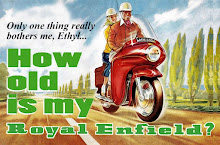The man asked me "is it for sale?"
The answer sprang to my lips:
"No, never!"
My own answer surprised me.
I've never considered my Royal Enfield to be the last thing I would hesitate to sell. I know it's just a machine.
It's unusual, but not unique. Many thousands like it exist. It was not an expensive investment, like jewelry.
I've never even given it a name. It's just "the motorcycle."
I like it. I'm emotionally attached to it.
But look: I'm 75. I will be parting with many material goods all too soon. Its turn will come.
So, my answer, in the moment, was a surprise to me. But there was a bit more to this interaction.
I was in the driveway, unpacking the car from a two-night camping trip in the Everglades. A kayak was still on the roof of the car.
The guy pulled up in the fanciest looking cream colored SUV I've ever seen. It literally glowed with lustrous paint and shiny metal, and must have cost a fortune. We live in a "nice" neighborhood, but this vehicle established a degree of economic well being out of character with my old Camry.
I didn't recognize the man, who was dressed in fine sport clothes that expressed a degree of economic well being out of character with my sweaty T-shirt.
"I see you have a motorcycle," he said, smiling, through the rolled down passenger window of his SUV.
This really surprised me. The motorcycle was in the garage, at least 30 feet away, and just a shapeless heap under multiple old sheets I throw across it to keep the dust off. How could he even see it?
"What kind is it?" he asked. I had to repeat "Royal Enfield" twice. He wasn't familiar with Royal Enfields.
"Who makes it?" was the next question. Rather than repeat "Royal Enfield" uselessly, I replied that "they're made in India. It's an old British bike. They never stopped making them in India."
"What does it look like?" was the next question. This was getting a shade odd. He wasn't directly asking to come in and have me show it off, but close.
"It's a naked motorcycle," I said. "This one is old looking. You can see them on the Internet," I said, maybe too warily. But he wasn't put off.
"It's a collector bike?" he asked.
This was getting odder. "Well," I said, with a shrug, "I collected it. It's a 1999. Nothing special."
That's when he asked "is it for sale?"
My answer, "no, never," said emphatically, seemed to end things. He wished me well, and drove off.
I know I behaved badly. I'm normally flattered and friendly when people ask about my Royal Enfield, as they often do when they actually see it. If this guy turns out to be a neighbor I just didn't recognize, I will be embarrassed.
Funny thing is, I have been on the "other side." I wrote recently about spotting a Royal Enfield in the parking garage of the condo where we stay when we visit Washington, DC. I left a note on the door of the apartment corresponding to that parking space, suggesting we get in touch.
I never heard back. Maybe the guy freaked out, same as I did. If so, he would have responded by clutching his Royal Enfield to his heart. Just like I did.








































